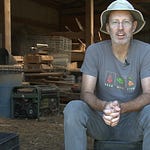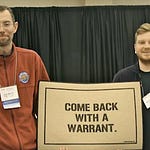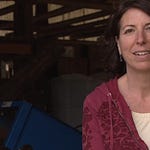January ‘22 were visiting family for the first time in years. Had a nephew who’d been conceived and born during the lockdowns who we’d never met, so we piled in the car and drove from the Atlantic to the Pacific staying in tiny home rentals along the way. Research.
It’s funny how fate steps in sometimes, the clouds part, the path opens. We’d started teasing the idea of buying raw land and building our own house because we hated the idea of a mortgage (the word’s origin is literally ‘death pledge’) and we love to build stuff. Even though we didn’t know what we were doing.
After a heartfelt but awkward family reunion~ days of hanging out only outside social distancing, decided to drive 24 hours roundtrip to go visit a friend we’d never met, Michael. Abraham, my son did not want to go, wanted to stay and visit with family, swim in the heated pool- but forced him to come because figured it would be a positive lifechanging experience, a decision that led to lots of crying on the 12 hour drive East to Kykotsmovi Village, Arizona. Hopi Nation.
The Smithsonian had emailed our website out of the blue the summer before and asked if we could create a three-screened art installation about American farmers for the US Botanical Garden. Said yes. Through the process was introduced to Michael, and everyone who edits video knows that when you spend hours going over footage of someone you edit a film about, you develop a one-way-friendship. Pouring over their life story on a screen, crafting and re-crafting the best way to bring it to life. So when you do finally meet, you get the same recognition as if meeting a friend, only to discover they don’t share the same sparkle of excitement.
After a speeding ticket and a night in a sketchy desert motel, we arrived in the parking lot of the Kykotsmovi General Store, a dirt lot where most of the reservation goes to get groceries. The Hopi reservation had an eerie feel to it, largely because there were lots of COVID related signs saying “Go Home, We Don’t Want You Here” a not-very-subtle suggestion to a person who most certainly didn’t feel a sense of belonging. But we had been very kindly invited by a member of the Hopi tribe, Michael, and so we proceeded despite the warnings.
He was indeed in the parking lot as we had planned and had what was probably a Subaru, although memory is never too accurate. What was unique about the car, however, was that on the back liftgate was a shovel, a cannister of gasoline and a spare tire. We were going into some seriously remote desert land, and Michael was prepared. He was not sure our vehicle would make it on the sandy roads. Overconfident, I assured him we could.
The reason for traveling many weeks on the road, and forcing my then seven year old son to join was because of how brilliant Michael is and how miraculous his farm is. As we followed him for about fifteen minutes away from the grocery store parking lot and eventually off the pavement, and along the single lane beach-type road, the scenery got more and more beautiful. The kind of beauty that cameras have little ability to communicate. A kind of timelessness that immediately creates humility and wisdom to look upon.
The Hopi are the only Native American tribe that was never displaced. Their reservation is indeed the land of their ancestors. No trail of tears. No broken treaties. Am guessing the reason for their uninterrupted autonomy is because they live in land that no Eurpoeans wanted. The desert. A place that gets less annual rain than a typical weekend in Seattle. And yet, over the millenia, Michael and his ancestors have developed remarkable, even magical methods of agriculture to coax food from the sand.
As we drove increasingly deep into the desert, and my concern for the car’s pathetically low clearance increased accordingly- I began to wonder where the farm was. And then in an instant realized, had been staring at it for many minutes already. It was just so much a part of the land around it, that it was pretty much invisible unless you were looking for it. More than a decade earlier, Michael had rejected the government ‘gifted’ dependency of HUD housing and struck out into the desert to build his own home in the ancient Hopi way. Making bricks from water and sand. Using the gnarled tough wood of the desert trees.
Like his ancestors, he chose to put the house near to a mountain, and to put the farm fields directly below the mountain so that when the rain comes in August, the channels carved into the rock by his people would guide the water down the auroras and into the field, creating just enough moisture for the Hopi corn to grow. Studied around the globe by botanists, this corn seems to defy logic, as it grows from the sand when planted as deep as 18 inches. A symbiotic relationship between people and seeds, in which the toughest of each category rose to survival. Michael clearly was from a long such line of brilliant surviving magicians. Farmers.
A brief interruption- Thanks so much to our paid subscribers. You make this work possible!
Abe got the boom pole out, and awkwardly kicked his way through the tumbleweeds as I tried to keep the same distance from him so as not to rip the XLR cables out of the built in sound mixer on the camera. For much of the past few years, he’s been my sound guy, a job of necessity that removed the need for a babysitter. Technically, it was mostly a failure, as Abe lurched into and out of the frame and often talked into the microphone at inopportune times. By now though, his tears had dried up, and he was beginning to see why I’d dragged him away from the relative pleasure of the trendy swimming pool-life of suburban Los Angeles. Like me, he was captivated by the home in the sand, and by the corn growing as if by God’s animation.
Michael, who is equal parts farmer and friend, poet and scientist, explained the fascinating life cycle of the kernel of corn, how the epicotyl shoots way down into the Earth in search of moisture, and simultaeously shoots up towards the surface. The seeds are planted in groups of five to ten, across irregular sections of the land and the competition among the seeds and placement in diverse geography helps ensure the plants fruition.
It was captivating stuff but Abraham kept accidentally knocking his headphones off, and eventually just decided to turn him loose and get some space. Overjoyed he ran around the farm, climbing the ladders up to the flat roof and exploring the many rooms and curiosities in the homemade house. Eventually Michael and I plopped a couple five gallon buckets on the roof and filmed the interview. He shared stories of his childhood, of his people and his passion for growing food. When he talked about how one could smell the rain when he cooked the Hopi corn it triggered deep emotions within, the kind of spine-tingling alarm that one is indeed in the right place.
As he talked about building his own home, i began to believe that we could do the same thing in the woods of the Northeastern US. Unbeknownst to me, within a few months of the interview with Michael, our family had indeed purchased raw land in SE Vermont and were building cabins from the trees that surrounded us.
Its what us humans, all of us- regardless of pigmentation- is programmed to do. Make a home from our surroundings.
As the light faded from the sky, we joined Michael in his house where a fire was roaring in his wood-burning stove. He showed Abraham how to use a drill, and encouraged us to return soon as we drove off into the night. The ride home back was far happier than the ride out.
Thanks so much to Michael for hosting us, and sharing his story.
And thanks to Abraham for going along for the ride, even though he didn’t really have a choice :).
best thoughts,
graham
p.s. for those keeping track- this short film is an excerpt from the upcoming feature film farming. we released this scene on our patreon previously, but it was accidentally deleted from substack, so we are reposting it here and have included a brand new essay about the creative journey.
p.p.s thanks to thomas for an awesome job on the edit, and to sarah, who went back and filmed a couple months after abraham and i left.












Share this post